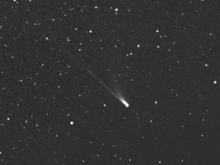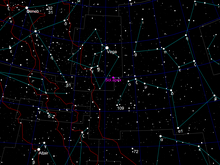Interstellar object
An interstellar object is a body other than a star or substar located in interstellar space, and not gravitationally bound to a star. They may include asteroids or comets (or exocomets).[1][2] Besides known comets within the Solar System, or known extrasolar comets,[3][4][5] at present, an interstellar comet can only be detected if it passes through the Solar System, and could be distinguished from an Oort cloud comet by its strongly hyperbolic trajectory (indicating that it is not gravitationally bound to the Sun).[2] Until 2017, the most eccentric known object, C/1980 E1, only had an eccentricity of 1.057,[6] far less eccentric than an interstellar comet would be expected to be.
The first discovered, and only known interstellar object to date, is ʻOumuamua (previously C/2017 U1 and A/2017 U1). The object has an eccentricity of about 1.20. It was initially named C/2017 U1 because it was assumed to be a comet, but was renamed to A/2017 U1 after no cometary activity was found.[7][8] After its interstellar nature was confirmed, it was renamed to 1I/ʻOumuamua – 1 because it is the first such object to be discovered, I for interstellar, and 'Oumuamua' is a Hawaiian word meaning "a messenger from afar arriving first".[9]
Nomenclature
With the first discovery of an interstellar object, the IAU is proposing a new series of small-body designations for interstellar objects, the I numbers, similar to the comet numbering system. The Minor Planet Center will assign the numbers. Provisional designations for interstellar objects will be handled using the C/ or A/ prefix, (comet or asteroid) as appropriate.[10]
Overview


Current models of Oort cloud formation predict that more comets are ejected into interstellar space than are retained in the Oort cloud, by a factor of 3–100.[2] Other simulations suggest that 90–99% of comets are ejected.[11] There is no reason to believe comets formed in other star systems would not be similarly scattered.[1]
If interstellar comets exist, they must occasionally pass through the inner Solar System.[1] They would approach the Solar System with random velocities, mostly from the direction of the constellation Hercules because the Solar System is moving in that direction, called the solar apex.[12] Until the discovery of 'Oumuamua, the fact that no comet with a speed greater than the Sun's escape velocity[13] had been observed was used to place upper limits to their density in interstellar space. A paper by Torbett indicated that the density was no more than 1013 (10 trillion) comets per cubic parsec.[14] Other analyses, of data from LINEAR, set the upper limit at 4.5×10−4/AU3, or 1012 (1 trillion) comets per cubic parsec.[2]
An interstellar comet can probably, on rare occasions, be captured into a heliocentric orbit while passing through the Solar System. Computer simulations show that Jupiter is the only planet massive enough to capture one, and that this can be expected to occur once every sixty million years.[14] Comets Machholz 1 and Hyakutake C/1996 B2 are possible examples of such comets. They have atypical chemical makeups for comets in the Solar System.[13][15]
1I/2017 U1 (ʻOumuamua)

A dim object was discovered on October 19, 2017 by the Pan-STARRS telescope, at an apparent magnitude of 20. The observations showed that it follows a strongly hyperbolic trajectory around the Sun at a speed greater than the solar escape velocity, in turn meaning that it is not gravitationally bound to the Solar System and likely to be an interstellar object.[17] On October 25, the object was found to be completely asteroidal in nature[7] and as a consequence has been designated as 1I/2017 U1, the first of a new class 'I' of astronomical objects. 1I/2017 U1 was named ʻOumuamua.
The lack of cometary activity from ʻOumuamua suggests an origin from the inner regions of whatever stellar system it came from, losing all surface volatiles within the frost line, much like the rocky asteroids, extinct comets and damocloids we know from our Solar System. This is only a suggestion, as ʻOumuamua might very well have lost all surface volatiles to eons of cosmic radiation exposure in interstellar space, developing a thick crust layer after it was expelled from its parent system.
ʻOumuamua has an eccentricity of 1.199, which is the highest eccentricity ever observed for any object in the Solar System by a wide margin.
See also
References
- ^ a b c Valtonen, Mauri J.; Jia-Qing Zheng; Seppo Mikkola (March 1992). "Origin of oort cloud comets in the interstellar space". Celestial Mechanics and Dynamical Astronomy. 54 (1–3). Springer Netherlands: 37–48. Bibcode:1992CeMDA..54...37V. doi:10.1007/BF00049542. Retrieved 2008-12-30.
- ^ a b c d Francis, Paul J. (2005-12-20). "The Demographics of Long-Period Comets" (PDF). The Astrophysical Journal. 635 (2): 1348–1361. arXiv:astro-ph/0509074. Bibcode:2005ApJ...635.1348F. doi:10.1086/497684. Retrieved 2009-01-03.
- ^ "'Exocomets' Common Across Milky Way Galaxy". Space.com. 7 January 2013. Archived from the original on 16 September 2014. Retrieved 8 January 2013.
{{cite web}}: Unknown parameter|deadurl=ignored (|url-status=suggested) (help) - ^ Beust, H.; Lagrange-Henri, A.M.; Vidal-Madjar, A.; Ferlet, R. (1990). "The Beta Pictoris circumstellar disk. X – Numerical simulations of infalling evaporating bodies". Astronomy and Astrophysics (ISSN 0004-6361). 236: 202–216. Bibcode:1990A&A...236..202B.
- ^ Sanders, Robert (7 January 2013). "Exocomets may be as common as exoplanets". University of California, Berkeley. Retrieved 8 January 2013.
- ^ "JPL Small-Body Database Browser: C/1980 E1 (Bowell)" (1986-12-02 last obs). Retrieved 2010-01-08.
- ^ a b K. Meech (25 October 2017). "Minor Planet Electronic Circular MPEC 2017-U183: A/2017 U1". Minor Planet Center. International Astronomical Union.
- ^ "We May Just Have Found An Object That Originated From OUTSIDE Our Solar System". IFLScience. October 26, 2017.
- ^ "Aloha, 'Oumuamua! Scientists confirm that interstellar asteroid is a cosmic oddball". GeekWire. 20 November 2017.
- ^ "MPEC 2017-V17 : NEW DESIGNATION SCHEME FOR INTERSTELLAR OBJECTS". minor planet center. 6 November 2017.
- ^ Choi, Charles Q. (2007-12-24). "The Enduring Mysteries of Comets". Space.com. Retrieved 2008-12-30.
- ^ Struve, Otto; Lynds, Beverly; Pillans, Helen (1959). Elementary Astronomy. New York: Oxford University Press. p. 150.
- ^ a b MacRobert, Alan (2008-12-02). "A Very Oddball Comet". Sky & Telescope. Retrieved 2010-03-26.
- ^ a b Torbett, M. V. (July 1986). "Capture of 20 km/s approach velocity interstellar comets by three-body interactions in the planetary system". Astronomical Journal. 92: 171–175. Bibcode:1986AJ.....92..171T. doi:10.1086/114148.
- ^ Mumma, M.J.; Disanti, M.A.; dello Russo, N.; Fomenkova, M.; Magee-Sauer, K.; Kaminski, C.D.; D.X. Xie (1996). "Detection of Abundant Ethane and Methane, Along with Carbon Monoxide and Water, in Comet C/1996 B2 Hyakutake: Evidence for Interstellar Origin". Science. 272 (5266): 1310–1314. Bibcode:1996Sci...272.1310M. doi:10.1126/science.272.5266.1310. PMID 8650540.
- ^ "Solar System's First Interstellar Visitor Dazzles Scientists". NASA/JPL. Retrieved 2017-11-25.
- ^ "MPEC 2017-U181: COMET C/2017 U1 (PANSTARRS)". Minor Planet Center. International Astronomical Union. Retrieved 25 October 2017.





